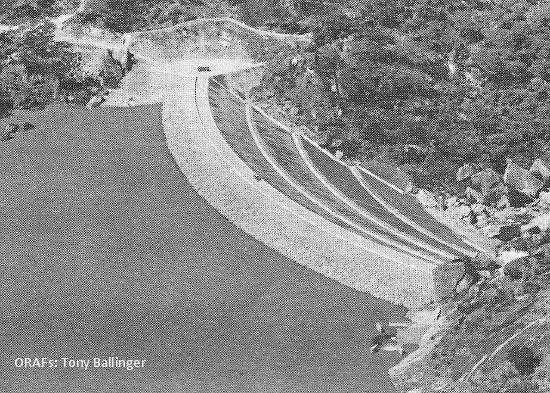
Above: Dams must not only meet economical criteria, they also must meet environmental, ecological, aesthetic and social considerations.
Because Rhodesia's water resources are derived entirely from the annual rainfall, which occurs during the summer months—from October to March —water has to be stored in dams to ensure adequate year-round supplies.
And in the past decade development of storage facilities has reached massive proportions. Rhodesia, a member of the International Commission on Large Dams, has built nearly 50 large dams throughout the country—almost double the amount built in the previous 65 years.
There are now 99 large dams (over five metres high), with a total storage capacity of 3 898 million cubic metres; and 7 215 small dams, with a storage capacity of 662 million cubic metres — a total of 7 314 dams together holding 4 560 million cubic metres of water.
"Most of the new large dams are in the Tribal Trust Lands, providing water for villagers' domestic use and irrigation schemes, others have boosted urban water supplies and yet others are providing extra irrigation to the vast lowveld cotton, wheat, sugar cane and citrus plantations.
The first step in developing Rhodesia's water resources is investigation and preparation of development plans for river catchments, eventually covering the whole country.
Every major dam affects the management of the river. It is affected by upstream development and, in turn, influences downstream development. So comprehensive plans for complete river catchments, with possible interlinking of them, are essential.
All this planning involves a great deal of work by engineers, hydro biologists, geologists, agriculturalists, economists and sociologists.
All alternative schemes must be investigated and the final report submitted for project approval will summarize the planning body's findings and recommendations.
One big problem is that there is very little reliable, long-term hydrological data, but this is being remedied by about 500 hydrological recording installations on all the country's main rivers.

Above: Irrigation schemes mean more crops to feed more people.
Effective planning consists of assessing overall potential water availability; considering existing development and use; carrying out feasibility studies of major storage sites to develop potential yield; forecasting future demand and consumption; investigating alternative schemes to provide water and the selection of the best alternative.
But storing water creates problems as well as bringing benefits. Large dams have a disturbing effect on the environment and this must be taken into account in the planning, building and management procedures.
Comparison of alternative schemes must be based not only on economic grounds, but also on environmental, ecological, aesthetic and social considerations.
On projected figures of population growth, to maintain present standards 36 new major dams and 2 600 smaller dams will have to be built.
It is estimated, on present use and growth, that Rhodesia's water resources will be sufficient until well into the 21st Century. But this date will be extended by future technological advances in the maximum development and use of water resources and also in the reclamation and re-use of waste water. So Rhodesia has time to plan and develop.
While water resources cannot be appreciably increased, they can be extended by greater efficiency in use and elimination of wastage, recycling- of water, reducing evaporation and re-charging underground aquifers. Cloud-seeding is another way of extending water resources and is already being effectively used.
Rising populations throughout the world are putting a heavy strain on the vital and limited water supplies. But Rhodesia, with one of the world's highest population growth rates, is working effectively to ensure that all those people will have the water they need.
Below: An unusual answer to a spillway problem. This method of taking away excess water from a dam employs a system similar to that of a bath plug-hole.

End
Extracted and recompiled by Eddy Norris from the publication Focus on Rhodesia Vol. 2 No. 8. Material made available by Tony Ballinger. Thanks Tony.
Publication not dated but is to believed to be from the mid to late 1970's.
Comments are welcome, please send them to Eddy Norris at orafs11@gmail.com
No comments:
Post a Comment